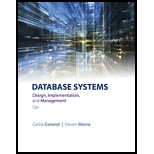
Database Systems: Design, Implementation, & Management
12th Edition
ISBN: 9781305627482
Author: Carlos Coronel, Steven Morris
Publisher: Cengage Learning
expand_more
expand_more
format_list_bulleted
Concept explainers
Expert Solution & Answer
Chapter 4, Problem 1RQ
Explanation of Solution
Conditions:
Following are the conditions should be met before an entity is referred as a weak entity:
- The entity should be “existence-dependent” on its parent entity.
- If an entity is referred as an “existence-dependent”, then that entity can exist in the
database if and only if when it is related with another entity existence.
- If an entity is referred as an “existence-dependent”, then that entity can exist in the
- The entity should inherits a section of its primary key (PK) from its parent entity.
Example:
Consider the following ER diagram along with its attributes:

Explanation:
- The entity CLASS is “existence-dependent” on COURSE entity. Hence the CLASS entity uses a PK component from its parent entity (COURSE).
- The CLASS entity’s PK is (COURSE_ID, CLASS_SEC).
- In this strong implementation, the CLASS entity is referred as a weak entity between COURSE and CLASS.
Want to see more full solutions like this?
Subscribe now to access step-by-step solutions to millions of textbook problems written by subject matter experts!
Students have asked these similar questions
Dijkstra's Algorithm (part 1). Consider the network shown below, and Dijkstra’s link-state algorithm. Here, we are interested in computing the least cost path from node E (note: the start node here is E) to all other nodes using Dijkstra's algorithm. Using the algorithm statement used in the textbook and its visual representation, complete the "Step 0" row in the table below showing the link state algorithm’s execution by matching the table entries (i), (ii), (iii), and (iv) with their values. Write down your final [correct] answer, as you‘ll need it for the next question.
4. |z + 5 - 5i| = 7
14.
dz,
C: |z❘
C: |z❘ = 0.6
ze² - 2iz
H
Chapter 4 Solutions
Database Systems: Design, Implementation, & Management
Ch. 4 - Prob. 1RQCh. 4 - What is a strong (or identifying) relationship,...Ch. 4 - Prob. 4RQCh. 4 - Suppose you are working within the framework of...Ch. 4 - Prob. 6RQCh. 4 - Prob. 7RQCh. 4 - Discuss the difference between a composite key and...Ch. 4 - What two courses of action are available to a...Ch. 4 - Prob. 11RQCh. 4 - Discuss two ways in which the 1:M relationship...
Ch. 4 - Prob. 13RQCh. 4 - Prob. 14RQCh. 4 - Briefly, but precisely, explain the difference...Ch. 4 - What are multivalued attributes, and how can they...Ch. 4 - Prob. 17RQCh. 4 - Prob. 18RQCh. 4 - What two attributes must be contained in the...Ch. 4 - Describe precisely the composition of the...Ch. 4 - Prob. 21RQCh. 4 - Prob. 1PCh. 4 - Create a complete ERD in Crows Foot notation that...Ch. 4 - Prob. 4PCh. 4 - Prob. 5PCh. 4 - Prob. 6PCh. 4 - Prob. 7PCh. 4 - Prob. 8PCh. 4 - Prob. 9PCh. 4 - Prob. 10PCh. 4 - Prob. 11C
Knowledge Booster
Learn more about
Need a deep-dive on the concept behind this application? Look no further. Learn more about this topic, computer-science and related others by exploring similar questions and additional content below.Similar questions
arrow_back_ios
SEE MORE QUESTIONS
arrow_forward_ios
Recommended textbooks for you
 Database Systems: Design, Implementation, & Manag...Computer ScienceISBN:9781305627482Author:Carlos Coronel, Steven MorrisPublisher:Cengage Learning
Database Systems: Design, Implementation, & Manag...Computer ScienceISBN:9781305627482Author:Carlos Coronel, Steven MorrisPublisher:Cengage Learning
 Database Systems: Design, Implementation, & Manag...Computer ScienceISBN:9781285196145Author:Steven, Steven Morris, Carlos Coronel, Carlos, Coronel, Carlos; Morris, Carlos Coronel and Steven Morris, Carlos Coronel; Steven Morris, Steven Morris; Carlos CoronelPublisher:Cengage Learning
Database Systems: Design, Implementation, & Manag...Computer ScienceISBN:9781285196145Author:Steven, Steven Morris, Carlos Coronel, Carlos, Coronel, Carlos; Morris, Carlos Coronel and Steven Morris, Carlos Coronel; Steven Morris, Steven Morris; Carlos CoronelPublisher:Cengage Learning Principles of Information Systems (MindTap Course...Computer ScienceISBN:9781285867168Author:Ralph Stair, George ReynoldsPublisher:Cengage Learning
Principles of Information Systems (MindTap Course...Computer ScienceISBN:9781285867168Author:Ralph Stair, George ReynoldsPublisher:Cengage Learning Fundamentals of Information SystemsComputer ScienceISBN:9781305082168Author:Ralph Stair, George ReynoldsPublisher:Cengage Learning
Fundamentals of Information SystemsComputer ScienceISBN:9781305082168Author:Ralph Stair, George ReynoldsPublisher:Cengage Learning

Database Systems: Design, Implementation, & Manag...
Computer Science
ISBN:9781305627482
Author:Carlos Coronel, Steven Morris
Publisher:Cengage Learning


Database Systems: Design, Implementation, & Manag...
Computer Science
ISBN:9781285196145
Author:Steven, Steven Morris, Carlos Coronel, Carlos, Coronel, Carlos; Morris, Carlos Coronel and Steven Morris, Carlos Coronel; Steven Morris, Steven Morris; Carlos Coronel
Publisher:Cengage Learning

Principles of Information Systems (MindTap Course...
Computer Science
ISBN:9781285867168
Author:Ralph Stair, George Reynolds
Publisher:Cengage Learning

Fundamentals of Information Systems
Computer Science
ISBN:9781305082168
Author:Ralph Stair, George Reynolds
Publisher:Cengage Learning